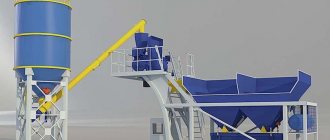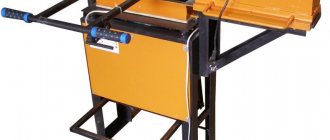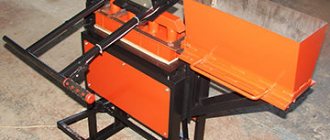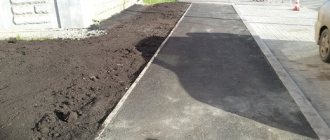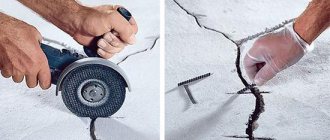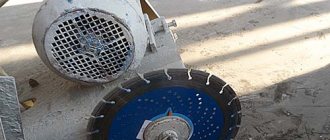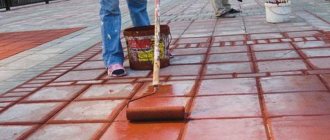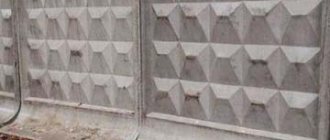In the process of laying the concrete mixture, it is necessary not only to maintain the correct proportion of sand, cement and water, but also to ensure that no voids appear in the cement mass. If, after pouring the solution, air pockets form in it, this will lead to a decrease in the density of the composition. In turn, this will cause cracking and destruction of the entire structure. To prevent this from happening, it is necessary to use a concrete compactor.
As a rule, compaction is performed using specialized equipment or through simple manipulations.
Methods for compacting concrete
Laying and compacting the concrete mixture can be done in several ways:
Pressing
This method is considered one of the most effective, but builders rarely resort to it due to the high cost of the equipment. The fact is that the presses used for compaction must have a pressure of at least 10 MPa. Equipment of this power is used in shipbuilding, so it’s easy to guess how much it will cost.
Centrifugation
In this case, the concrete mixture is compacted in a centrifuge. During its rotation, the solution is forcefully pressed against the walls of the equipment, and water (more than 30%) and excess air are effectively “squeezed out” from the composition.
Healthy! If you use centrifugation technology, then the cement consumption must be significantly increased.
Vacuuming
The compaction of the mass occurs due to rarefaction of the air. Under extreme pressure, all excess is removed from the laid solution, and the density of the composition increases significantly. However, not everyone can afford such equipment.
Manually
This method of concrete compaction is suitable for processing a small amount of mixture for the construction of your own country house, cabin or bathhouse. When processing concrete mass manually, absolutely everything is done with your own hands. First, a solution is prepared, which is mixed not in a concrete mixer, but in an ordinary trough. After this, using a manual tamper, bayonet and other devices, the concrete solution poured into the formwork is “pierced” over the entire area in increments of 5-10 cm. Thanks to this, all excess air and moisture is removed from the mass.
This also includes manual tamping, which involves the use of homemade or ready-made, simple mechanical devices for compacting heavy concrete mortar.
These are the simplest and cheapest ways to compact concrete yourself.
If it is not possible to work manually or the area of the object is too large, it is worth considering other methods of compacting the concrete mixture. The simplest and most inexpensive of them is the mechanical compaction method, which involves the use of vibration-type equipment.
Types of vibration platforms
The vibration platform consists of two frames. A container with concrete mixture is placed on the movable top. The lower one, motionless, is fixed to the foundation. The upper frame with a vibration mechanism located on it rests on a stationary frame by means of shock absorbers - springs, springs, rubber gaskets.
The vibration mechanism, as a rule, consists of shafts with unbalances, which are driven into rotation by an electric motor.
The upper movable frame must have sufficient rigidity. Otherwise, an uneven amplitude of vibrations will be observed. In areas with weak vibrations, the compaction of the mixture will be insufficient.
Mechanical seal
For large volumes of concrete mixture, it is recommended to use specialized equipment.
Surface vibrator
Compaction of concrete mixture with surface-type vibrators is most often used for large areas and a small layer of building mixture. Thanks to this equipment, compaction is performed:
- slab bases;
- floors;
- retaining walls;
- dams;
- road surfaces.
A device of this type also consists of a plate, which is connected to a vibration mechanism. Surface equipment creates vibrations that travel 20-30 cm deep into the solution. This is more than enough to treat a surface of small thickness.
If the height of the concrete base is much greater, then it is recommended to use the vibrating plate after processing with an internal vibrator.
Internal vibrator
A deep vibrator allows you to compact the concrete mixture in a more efficient way, due to the fact that in this case the vibration energy is transferred directly into the concrete composition.
These vibrating concrete compactors are easy to operate and can be used in hard-to-reach areas without any problems.
To use this device:
- Place it in a vertical position.
- Move the vibrator to another part of the surface in increments of 45-75 cm.
- Immerse the device at a speed of no more than 2-3 cm/s.
Important! A deep vibrator cannot be used to distribute the solution over the formwork, otherwise concrete delamination will occur.
Another advantage of the internal vibrator is that it can be used not only for compaction, but also for leveling the surface.
Vibrators for formwork
Sometimes concrete compaction by vibration is performed using equipment that is rigidly fixed directly to the formwork. Thanks to the vibrations coming from the vibrator, the mixture is compacted quite quickly and efficiently.
Formwork vibrators are most often used when concreting complex or non-standard structures.
Important! If you plan to use this type of vibrator, it is necessary to create a very rigid and reliable formwork that is resistant to vibration loads.
It is worth paying attention to one feature of using such equipment - during the compaction process, air bubbles are formed in the upper layer of the solution. In order to get rid of them, it is necessary to modify the top layer of the surface manually or using a deep vibrator.
Healthy! All vibrators are pneumatic or electric. The first type is considered easier to manage and safer. However, pneumatic equipment may not withstand low temperatures in winter.
To select the highest quality and inexpensive equipment for vibratory compaction of concrete, you should pay attention to the brand and manufacturer of the device.
Vibration compactors overview
Builders most often prefer the following models:
Sturm CV7120
This vibrator is durable and highly reliable. Although the portable unit is manufactured in China, it is sold under the brand of a German company that has proven itself well in our market.
The deep vibrator Sturm CV7120 is equipped with a flexible shaft, so it is convenient to use when compacting concrete for reinforced concrete walls, basements and columns.
Unit power 2000 W, vibration frequency 18,000 vibrations/min. At the same time, the equipment weighs a little more than 5 kg.
Advice! If your choice fell on this particular model, then it is better to immediately buy a spare shaft with a mace, since it will be difficult to find them from other suppliers.
The cost of Sturm CV7120 is from 14,000 rubles.
Hervisa Runner Plus 52
Another compact compactor for concrete belongs to the category of professional deep-water equipment. These units are produced by a Spanish manufacturer of the same name, which has been manufacturing vibration equipment for more than 30 years.
The main advantage of Hervisa is the presence of a voltage converter and reliable protection against power surges and overheating. At the same time, a vibrator weighing about 17 kg is capable of processing up to 40 m3 in just 1 hour. In addition, the unit is equipped with a reliable drive and a flexible shaft.
The power of the equipment is 1500 W at a vibration frequency of 12,000 vibrations/min. The unit costs about 109,000 rubles.
Red Mayak IV-98E
Those who prefer equipment from Russian manufacturers should purchase the Krasny Mayak IV-98E site model. This unit can be mounted both on the formwork and on the slab to create a surface vibrator.
The Red Lighthouse weighs 22.5 kg, but it is compact in size. The engine, shaft and unbalances of the unit are protected by a durable metal casing.
Red Mayak can be used not only for compacting solutions, but also for the manufacture of vibrating tables and other equipment.
The vibrator has a rather low power of 900 W at a vibration frequency of 3000 vibrations/min. The unit costs about 10,500 rubles.
Models such as Wacker Neuson AR 36/3/230 costing about 20,000 rubles, Caliber VER 1500 (from 3,000 rubles), Makita BVR450Z (13,500 rubles) and Grost VGB 4000 W (from 17,000 rubles) can also boast positive reviews. .
Before using the equipment, it is necessary to take into account the difference in the volume of the mixture before and after compaction.
Compaction factor
Before you start using vibration equipment, you need to take into account a very important parameter - the compaction coefficient of the concrete mixture. The fact is that after removing air and excess moisture from the concrete solution, its thickness decreases.
Ready-made mixtures produced in factories have a coefficient of efficiency of 1.02, that is, the volume of concrete mass decreases by 2%. These requirements fully comply with SNiP.
If we talk about the compaction of asphalt concrete, its coefficient will be slightly higher. It is worth considering that everything depends on the consistency of the mixture, its grain size and the construction site itself. As a rule, increased heat loss occurs when paving:
- sidewalk paths;
- blind area for buildings;
- freeways
Also in SNiP there is the concept of averaged coefficient, which is 1.05 (about 5%). Based on these data, it will not be difficult to calculate the volume of concrete you will need for the job.
The use of compaction equipment will improve the characteristics of the concrete mixture. If you do not have the opportunity to purchase a vibration installation, use the manual compaction method.
4.3.1 Machines for preparing concrete mixtures
The technological process of preparing mixtures includes sequentially performed operations: loading dosed components (binders, fillers and water) into a mixing machine, mixing the components and unloading the finished mixture.
Mixers are classified according to three main characteristics: the nature of their work, the principle of mixing, and the method of installation.
According to the nature of the work, mixing machines are divided into periodic (cyclic) and continuous ones. In cyclic mixers (Figure 4.15 a.d), mixing the components and dispensing the finished mixture is carried out in separate portions. Each new portion of concrete or mortar components can be loaded into the mixer only after the finished batch has been unloaded from it. Cyclic mixers are usually used when brands of concrete mixtures or solutions are frequently changed. You can adjust the mixing time in them.
In continuous mixers (see Figure 4.15 e), the loading of components, their mixing and dispensing of the finished mixture are carried out simultaneously and continuously.
Figure 4.15 - Schemes for mixing materials in mixing machines
The dosed components enter the mixer in a continuous flow and are mixed by blades as they move from the loading opening to the discharge opening. The finished mixture is continuously supplied to vehicles or a supply hopper. Continuous mixers are best used for preparing large volumes of concrete or mortar mixture of the same brand.
